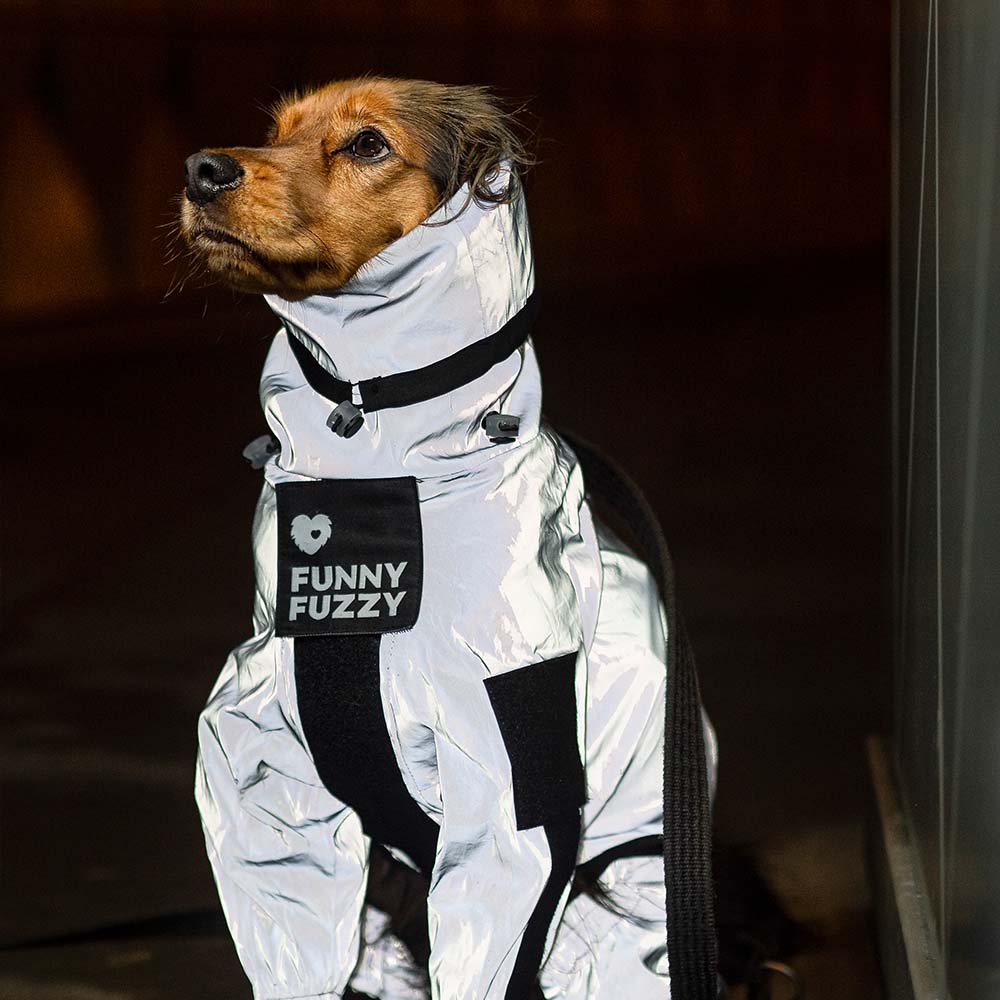Noticing gunk, goop, or sticky mess around your dog's eye? You’re not alone. Many UK dog owners see eye discharge and wonder if it’s normal or a sign of something serious. Sometimes it’s just mild watery eye discharge, like tear stains. Other times, thick, yellow or green discharge could mean an eye infection or another issue.
In this guide, we’ll explain the types of dog eye discharge, what causes them, when to worry, and how to care for your dog’s eyes at home—safely and easily.

Common Types of Eye Discharge in Dogs
Dog eye discharge comes in many forms. Typically clear tears are perfectly normal and help lubricate the surface of the eye. After long naps, a small amount of dry crust or little goop in the inner corner is completely normal.
When colour or texture changes, it can point to different types of dog eye problems:
-
Watery eye discharge / watery eyes / excessive watering – often linked to allergies (pollen, dust, mold spores, perfumes), wind, or air irritants.
-
Yellow or green discharge / yellow eye discharge / yellow‑green – may suggest bacterial conjunctivitis, viral infections, or another serious infection that needs veterinary attention.
-
White‑gray mucus / more mucus / increased eye mucus production – can happen with dry eye (keratoconjunctivitis sicca) when the eye makes fewer tears.
-
Bloody discharge – rare and potentially serious, sometimes linked to corneal abrasions, corneal ulcers, or other eye injuries.
-
Tear staining / reddish brown discoloration on light‑coloured dogs – usually just a cosmetic concern. Tears contain a pigment called porphyrin that turns reddish brown as it dries on fur around your dog’s eyes (“dog eye boogers” or eye goop may also be visible).
Some dog breeds with prominent eyes or anatomical abnormalities—like Pugs, Bulldogs, Boxers, Boston Terriers, and Cocker Spaniels—are more prone to a range of eye conditions.
Normal vs. Not-So-Normal Discharge
Most dogs will have about the same amount of clear eye gunk each day. But changes in color, thickness, or amount can signal a problem.
Normal (nothing to worry about):
-
A small amount of clear discharge or dried tears at the corner of the eye in the morning.
-
Watery eyes after wind or play—if your dog is otherwise normal in other respects.
Not normal (make an appointment):
-
Green or yellow discharge, eye redness, swelling, squinting, blinking, or clear pain/discomfort.
-
Excess discharge that looks sticky or thick, or one eye suddenly worse.
-
Other worrisome symptoms such as rubbing, itchy eyes, sensitivity to light, or head shyness.
Left untreated, these signs can develop into deep ulcers, complications, or even blindness. If you’re concerned, take your dog to the vet.
Common Causes of Dog Eye Discharge
Many things can cause eye discharge in dogs. Some are mild and can be managed at home. Others need quick vet care. Here are the most common causes, especially for UK pets.
1. Airborne Allergies
Pollen from grass and trees, dust mites, and even prolonged exposure to wind or smoke can irritate your dog’s eyes. This often leads to excessive tearing or watery discharge.

2. Eye Infections
Bacterial or viral conjunctivitis (also called pink eye) causes sticky discharge, often yellow or green. Infections are common if your dog’s immune system is low or if they have a foreign body in the eye.
3. Blocked Tear Ducts
Tears usually drain through tear ducts. If blocked, tears overflow, causing watery eyes and tear staining—especially in long hair or short-nosed breeds.
4. Dry Eye (Keratoconjunctivitis Sicca)
This means your dog isn’t making enough tears. You might notice thick discharge, eye redness, or discomfort. A Schirmer tear test at the vet can confirm this.
5. Injury or Foreign Material
Corneal wounds from dust, sand, or rough play can cause bloody discharge or swelling. If your dog squints or blinks rapidly, it could be due to pain or an object stuck in the eye’s surface.
Easy Home Care Tips for Mild Discharge
For mild discharge without other worrisome symptoms, simple home steps can help maintaining eye health:
-
Clean gently with a cloth dampened with warm water (or a damp cloth). Wipe from the inner corner outward to remove debris and crust; avoid touching the clear layer on the surface of the eye.
-
Keep the fur around your dog’s eyes trimmed short to prevent material from sticking. A simple tidy trim can reduce tear staining on light‑coloured coats.
-
Ask your veterinarian about artificial tears or a soothing eye cleaning solution to support the tear film and the eye’s natural defenses.
-
Limit prolonged exposure to wind, air irritants, and pollen. Indoors, reduce dust mites and mold spores; outdoors, consider dog goggles for exposed eyes.
-
Some owners find an antibiotic‑free nutritional supplement helps reduces tear staining in many cases—this is a cosmetic concern only and not a medical treatment.
If discharge increases, changes colour, or your dog appears uncomfortable, make an appointment for an eye examination.
When to See a Vet
Book a vet visit if you notice yellow or green discharge, pain, redness, squinting, swelling, or other conditions that fail to improve in a day or two. The vet can perform tests to determine the underlying cause and treat it:
-
Schirmer tear test (a simple procedure called a tear test) to measure tears; treatments may include tacrolimus drops to replace or boost tear production in dry eye.
-
Stain and pressure checks to find ulcers and increased eye pressure.
-
Flush a blocked tear duct (often a simple procedure).
-
Topical medication / antibiotics / ointments / drops for bacterial infection; oral medications in tougher cases.
-
Surgical treatment for eyelid abnormalities or severe wounds when required.
Left untreated, problems can advance quickly and lead to damage or blindness—so take your dog promptly if you’re concerned.
Can Dog Eye Discharge Be Prevented?
You can’t prevent every problem affecting the eye, but these steps help with maintaining eye health:
-
Daily checks around your dog’s eye health—note any change in colour, consistency, or size of the discharge.
-
Clean gently each week with warm water or a vet‑approved solution; remove porphyrin‑stained fur build‑up.
-
Keep hair around your dog’s eyes short; dog produces fewer problems when debris can’t accumulate.
-
Manage allergens (pollen, dust, mites) and avoid prolonged exposure to smoke or strong perfumes.
-
Good nutrition supports all the functions of the eye, including tear glands that produce tears.
These ways won’t solve every issue, but they reduce risk and keep the tear film healthy.

Dogs with anatomical abnormalities, like prominent eyes, abnormal eyelashes, or cherry eye, need extra care. If your vet finds birth defects or abnormal corneal pigmentation, they may suggest surgery or long-term treatment.
FAQs
When should I be concerned about my dog's eye discharge?
If your dog has yellow discharge, green discharge, swelling, or is blinking more than usual, it’s time to visit the vet. Sudden or painful symptoms should never be ignored.
What can I do for my dog's gunky eyes?
Clean gently with a damp cloth or cotton ball and warm water. If the discharge keeps coming back or changes colour, ask your vet about topical medication or further testing like a Schirmer tear test.
Should I take my dog to the vet for eye discharge?
Yes, especially if there’s bloody discharge, watery eyes that don’t clear up, or signs of pain. Viral conjunctivitis, dry eye, and corneal ulcers can worsen if left untreated.
How do you treat yellow discharge from a dog's eye?
Yellow eye discharge often means bacterial conjunctivitis or another eye infection. Vets usually prescribe topical antibiotics, special eye drops, or oral meds, depending on the underlying cause.
Conclusion
Eye discharge is a common issue in dogs. While sometimes a little bit of clear tearing is normal, yellow or green discharge, severe discomfort, or worrisome symptoms mean it’s time to schedule a vet appointment. With the right diagnosis and treatment, most dogs respond well, and you’ll be maintaining better eye health for life.




